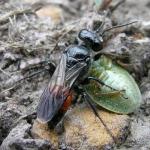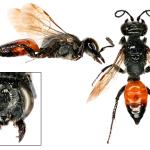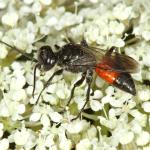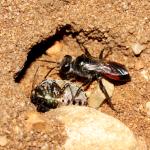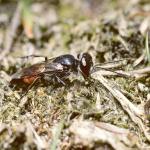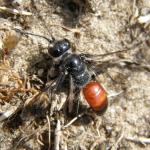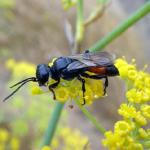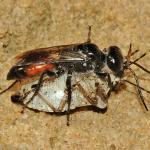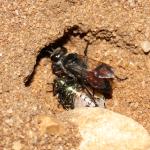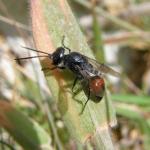Tiphia abdominalis (PANZER,1798); Larra pompiliformis (PANZER,1804); Dimorpha oculata (JURINE,1807); Astata victor CURTIS,1829; Astata vanderlindeni ROBERT,1833; Astata agilis SMITH,1875
In Britain, this species is confined to southern England, East Anglia and the Channel Islands. Widely distributed in the Palaearctic Region, east to India, northern China and Korea.
Not listed in Shirt (1987) or Falk (1991); the restricted range suggests revision of its status is needed. Nevertheless, this is a common wasp over much of its range.
Mainly sandy localities, such as inland heaths and coastal dunes. It can also be found in dry clay banks in woodland clearings (M Edwards, pers. comm.).
Univoltine; June to August.
Nymphs of pentatomid bugs (Heteroptera).
According to Tsuneki (cited by Lomholdt, 1975-76) the nest is a burrow about 10 cm long terminating in one to three cells, which are placed one after the other as simple dilations of the tunnel. There are sometimes side branches, so that the nest may have as many as 12 cells. The female wasp flies the prey to the nest, where it is stored near the sealed nest entrance until there is sufficient to provision several cells. The egg is laid on the first stored bug in each cell. The larva develops in three days in Korea, where there may be more than one generation per year. In British and Scandinavian populations the species probably overwinters in the pupal stage (Lomholdt, 1975-76). Males guard small stones or twigs lying on the ground, making inspection flights every few minutes and returning to the same spot. They turn to face anything new in their field of vision (M Edwards, pers. comm.).
The species can sometimes be found in numbers on flowers of umbellifers (Richards, 1980), including wild carrot (S P M Roberts, pers. comm.).
The chrysidid wasp Hedychridium roseum is a known parasitoid or cleptoparasite (Morgan, 1984).
1998


